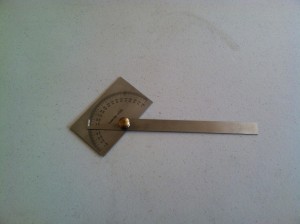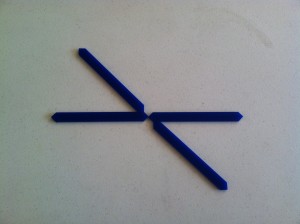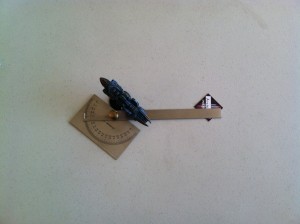Back in Scenario One (the Battle of Ascension) I talked about how ship rotation was short enough to be ignored by Starships. In this scenario, I make the opposite assumption: ship rotation takes a whole turn.
There are a couple of things that might make this happen. Instead of 15-minute turns, they might be two-minute turns. Or some of your ships might be considerably longer than 500 feet (or 150 meters) — which might be true if you’re playing with Battlefleet Gothic ships. (Somebody did a calculation based on the size of a model’s launch bays, and concluded the cruisers had to be around 5 km long.)
As this scenario is set in the Star Noir universe, we’ll be going with two minute turns. Either way, you’ll need to plot a ship’s trust without rotating it.
The Protractor and Its Use
For playing this scenario, I recommend a protractor of the type shown above. They’re available from pretty much any hardware store and (of course) Amazon. This one consists of an arm and an angle measure; the arm can be rotated around the measure, and locked in place by tightening the brass knob. (A full-resolution version of each of the pictures in this post can be viewed by clicking on it.)
That locking feature is important, as it will allow us to take advantage of the vertical angle theorem.
The vertical angle theorem is that one that says opposite angles are the same. Which means that if this is a 40º angle …
… then so is this one:
This means that you don’t need to actually read the tiny print on that protractor. Instead, you lock in the angle that the ship currently makes with its path …
… and then flip the protractor to find the ship’s line of thrust.
The Battle of Luna
The Battle of Luna was fought on the dark side of Earth’s Moon, for reasons that no one but the Tzcheenucoatl fully understand. The battle was fought in the lull between the two interstellar wars, and it’s speculated that Tzcheenucoatl agents found something on Luna that they did not believe they could smuggle through Earth’s (notoriously corrupt) customs. Whatever it was, they didn’t want Earthlings to know it even existed.
It was also important enough that Tzcheenucoatl sent their entire cold navy: three destroyers and their escorts. Two destroyers and the escorts were the screen for the third, which nearly scraped the surface of the moon and picked up something on the fly.
S5.1 Scenario Set-up
Scale: the distance scale is 500 km/inch, and one turn is 2 minutes.
Roles: Tzcheenucoatl is the attacker, and Old Earth is the defender.
Objectives: Tzcheenucoatl, skyhook (see rules below); Old Earth, fleet engagement.
Postures: Tzcheenucoatl is in pursuit, and Old Earth is dispersed.
Location: Earth’s moon is a 4″ (rock) garden world placed in the center of the table. The Area of Operations is jump-blocked.
S5.2 Earth’s Moon
The moon is represented by a circle of 4-inch diameter, to match the scale. The moon’s gravity is negligible, so ignored.
S5.3 Ship Construction
All ships’ Thrust value is limited to 2. (Given the scale, this is one gee.)
Overthrust values are similarly limited to 4. (The ship is not likely thrusting at 2 g’s, but “pulsing” at a higher rate that averages to 2 g’s.)
If you replace the Thrust and Overthrust values on the generic escorts and destroyers, the resulting point costs are as follows:
Laser Escort - 60 Mine Escort - 52 Spine Escort - 56 Missile Destroyer - 318 Spine Destroyer - 276 Multi-role Destroyer - 312 Light Carrier - 294
The generic cruisers and behemoths don’t change. Reduce the generic freighter’s Thrust to 2.
(Note: this is, indeed a reprint of scenario one’s construction rules. Like the Battle of Ascension, this battle is set at a more realistic representation of scale than Starships.)
S5.4 Movement
During a movement phase, a ship may only thrust or only rotate. A ship cannot do both.
To thrust or overthrust, use your protractor to maintain the ship’s facing at the inertia marker.
To rotate, use a coast move.
S5.5 Special Orders
Any order with the prerequisite of “coast” must maintain the ship’s facing as well.
Scenario rule S1.4 (marking an enemy) may not be used at this scale.
S5.6 The Skyhook
Once a turn, the attacking force may attempt a skyhook. Treat this as a special order, with the prerequisite that the ship may not already be following a special order. A skyhook is successful if a destroyer ends its turn within 1/2-inch of the moon.
Historical Forces
Tzcheenucoatl sent its entire cold navy: one generic multi-role destroyer (intended to execute the skyhook), two generics missile destroyers, and six generic laser escorts.
Old Earth wasn’t expecting a fight. Their fleet was a mismatched collection of available forces, old and new: two generic light carriers, one spine destroyer, and one missile destroyer.
Aftermath
Given the that Earthlings had no clue what the Tzcheenucoatl were up to, the operation appeared to be successful. The skyhooking destroyer picked up something off of the moon, and escaped back to Tzcheenucoatl.
When UN inspectors arrived at the site abandoned by the Tzcheenucoatl, they discovered that the Tzcheenucoatl had dug something out of the ground, and then dynamited the excavation to obscure any evidence.
Recommended Optional Rules
S1.5 Drones
Acknowledgments
Battlefleet Gothic is Games Workshop’s discontinued space combat game. GW doesn’t support it any more, so there’s nothing to link to.
Audacity is a Conquest-class battleship from the Terran Republic Navy. It’s available from Ravenstar Studios.
The protractor doesn’t have a manufacturer’s label on it, or I’d mention whose it was. The blue plastic templates are probably from Gale Force 9, but it looks like they’re too cool to make accessories now that they make games.






